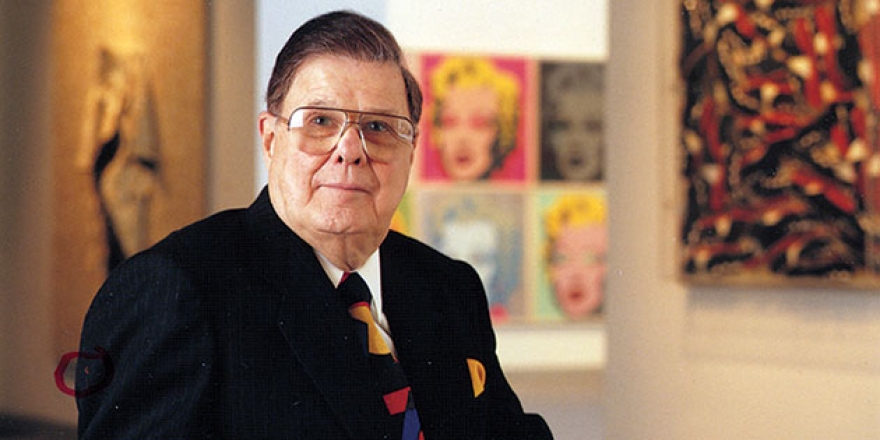The Making of a Museum
As the Frederick R. Weisman Museum celebrates 25 years on the Malibu campus, museum director Michael Zakian reflects on how the contemporary art collection came to Pepperdine
Frederick Weisman believed that art was to be enjoyed by everyone. A self-trained art enthusiast and collector with a successful business background, Weisman amassed a remarkable collection of contemporary art over the course of his lifetime. Before his death in 1994, Weisman undertook numerous philanthropic endeavors to ensure that the public would have ongoing access to the works in his collections, and one of the most significant was his founding of the Frederick R. Weisman Museum of Art at Pepperdine in 1992.
Weisman was first introduced to Pepperdine that same year, when the longtime curator of his personal collection, Nora Halpern, became director of what was then the Pepperdine University Art Gallery. Knowing that Weisman was interested in finding a Southern California home for his collection, Halpern invited him to visit the space. Weisman quickly realized that Pepperdine’s commitment to educating the whole person—body, mind, and soul—aligned with his ideals of accessibility and discovery.
In August of that year, he gave a $1.5 million gift to Pepperdine and the art gallery was renamed the Frederick R. Weisman Museum of Art. According to a Los Angeles Times article announcing the gift, Weisman pronounced, “It’s very exciting. What could be better than having a museum in my hometown? I have long sought an appropriate forum in the Los Angeles community to demonstrate my interest in the art of our century and of California.”
As a collector and exhibitor, Weisman refused to answer to others. Never reliant on art historians or experts to select new works, he catered to his own tastes by purchasing things that he loved. At Pepperdine, Weisman found a home for his art where he could put works from different artists and different eras together.
“Traditional museums place Renaissance art in the Renaissance galleries, African art in the African galleries,” says Michael Zakian, director of the Frederick R. Weisman Museum of Art since 1995.
“At Pepperdine, Weisman could put objects together from different countries, periods, and styles so that viewers could make comparisons and connections that even the artists didn’t see.”
The museum’s first exhibition, “Selections From the Frederick R. Weisman Foundation Collection,” opened September 12, 1992, and included 45 works by well- known artists such as Andy Warhol, Claes Oldenburg, Edward Ruscha, Joe Goode, and Roy Lichtenstein. Since then, the museum has hosted numerous acclaimed exhibitions, many of which have been overseen by Zakian.
One of the most significant shows to be held at the Weisman was the 1996 retrospective of modernist painter Agnes Pelton. As curator, Zakian worked for three years to track down Pelton’s paintings, which had been mostly forgotten—much like the artist herself who passed away in 1961. The works themselves were beautiful nature-based abstractions from the early 1930s of the desert outside of Palm Springs.
“Today, because of this exhibition, she’s California’s Georgia O’Keeffe,” says Zakian. “The cataloguing and display of these works was huge for the history of American art. In fact, LACMA just acquired a work of hers, as did the Fine Arts Museums of San Francisco and the Phoenix Art Museum.”
Other notable exhibitions over the years included Rodin’s Obsession: The Gates of Hell (2001), featuring dozens of bronze sculptures derived from Rodin’s famous, never-to- be-realized Parisian entryway;Roy Lichtenstein: In Process (2011), a show that chronicled the creation of the pop artist’s works from simple sketches to final products; andChihuly Los Angeles (2005), featuring site-specific glassworks by artist Dale Chihuly. To this day, Chihuly remains the most popular show in the Weisman’s history with more than 31,000 visitors over four months.
In celebration of the museum’s 25th anniversary this year, the Weisman is hosting California Dreaming: Contemporary Art from the Frederick R. Weisman Art Foundation (through December 10), an exhibition that looks at contemporary Californian art from the 1960s to the present, with an emphasis on historic works. The work on view, curated by Weisman’s widow Billie Milam Weisman, director of the Frederick R. Weisman Art Foundation, reflects Weisman’s deep personal relationships with many of the artists and chronicles the period when Los Angeles emerged to become one of the nation’s leading art centers.
“It is one of the most colorful and visually dynamic exhibitions we’ve ever done, with all of the artists drawing upon California’s light and color,” says Zakian.
Today, as it has since 1992, the museum focuses on being true to Weisman’s passion for art being open to all people.
“While on a certain level, art is more accessible to the general public than ever before due to technology, some people still find art a little off-putting and challenging,” notes Zakian. “One thing we try to do at the museum is break down those barriers.”
This means that exhibitions are designed to provide a visual experience that can strike the emotions of visitors. Oftentimes, they feature a message that can be clearly discovered or that is explained in comprehensive wall texts. This way, anyone who walks through the galleries can learn or experience something new.
As Weisman once said, “I don’t think there is anything that communicates better than art. It is quicker than language and clearer than philosophy.” Everyone who has walked through the Weisman at Pepperdine and encountered something profound, challenging, beautiful, or simply different than what they’re used to can be thankful for his vision.
